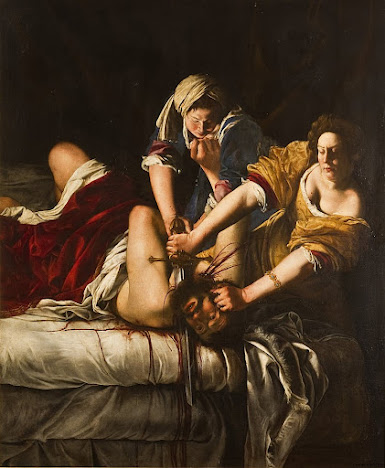Baroque Blog Assignment
In my last blog, I covered Caravaggio's "The Calling of Saint Matthew". While I had included this in a post meant to cover paintings from the Renaissance, it is actually a baroque. In spite of making such an embarrassing mistake, I found a new appreciation for tenebrism. This is all to say that I was drawn to Artemisia Gentileschi's "Judith Slaying Holofernes" from the moment I saw it. The painting shows clear tones of tenebrism and humanism, with historical and religious undertones that give the painting even more depth once you learn about it. The painting depicts Judith and her maid slaying and decapitating Holofernes, an Assyrian general. Holofernes, in his lust for the widowed Judith, allowed her into his tent, then got drunk. Originally planning to take advantage of Judith due to his power as a general, it's ironic that she was the one to kill him. Judith killed Holofernes as he was about to invade and raze the city of Bethulia, where Judith lived. The slaying and beheading of Holofernes presents Judith as being a willful and strong woman not only in a time when women were considered less than men, but also after being widowed and persecuted by a man who would destroy her home and take advantage of her using his power as a general. Everything from the look on Judith's face showing that Holofernes' slaying is nothing more than a chore to the look of disdain her maid shows at having to cut his head off all exude an air of monotony and due diligence. I'm sure that every one of you have had someone try and put you down with their power, and I'm equally as sure that you've loathed them for it. This painting encapsulates that breaking point; when you're done with being put down and you have nothing left but disgust and duty, only then will you face that force that has left you feeling powerless. When you finally fight back, you realize that the very thing that felt so daunting and oppressive can be so easily overcome as long as you're willing to stand up against it.




I like this painting but would not own it. It does indeed encapsulate the anger and frustrations of females reaching a breaking point after having to continually fight for the right to chart our own destiny, to be treated fairly, equally and with dignity instead of succumbing to male dominance.
ReplyDeleteAs a child of the late fifties who has personally fought (without violence) male dominance, and discrimination through the 60s, 70s, 80s to this current date, this really struck a chord with me.
I love that the women have a powerful, no-nonsense look on their faces, and that Caravaggio painted the general in such a vulnerable state of undress.
I really like this piece of art and would definitely own it. I've seen it in someone else's blog, and when I commented on that one I described the painting as "girl-boss" and "slay", and those are definitely two qualities that I would want displayed somewhere in my house. I think religious undertones is something of an understatement, given that it's a depiction of a (debatably) biblical event. As a deuterocanonical book, the book of Judith is tied very closely to the conflict between the Catholic Church and the Protestant Reformation. The Catholic Church considers deuterocanonical books as a part of the bible, while the Protestants question the books canonicity.
ReplyDeleteWhat an electric picture. It automatically caught my attention. You can see the blood racing down the side of the bed as Judith is killing the General. This painting to me is a powerful depiction of female strength and triumph over male aggression. It symbolizes themes of courage, justice and the power of women. It shows intense emotion and drama on Judith and the Maid's face.I showed my wife this painting and she automatically said “ I WANT IT “ I personally am not a fan of Baroque art. For me it's too dark. Artemisia was beyond her time as a powerful artist in a male dominated world. Most of her paintings were depictions of successful and strong women. Her work is great and absolutely jumps out and captures you.
ReplyDelete